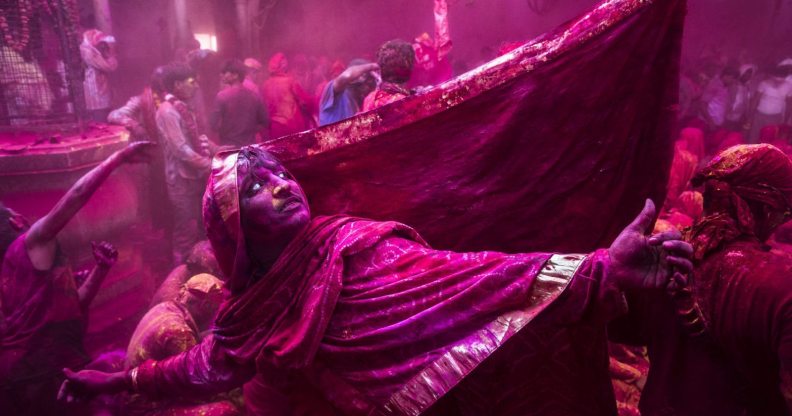Tritiya Prakriti: the hidden third gender in Hinduism

BARSANA, INDIA – MARCH 21: A transgender Hindu devotee dances during Lathmaar Holi celebrations on March 21, 2013 in the village of Barsana, near Mathura, India. The tradition of playing with colours on Holi draws its roots from a legend of Radha and the Hindu God Krishna. It is believed that young Krishna was jealous of Radha’s fair complexion since he himself was himself very dark. After questioning his mother Yashoda on the darkness of his complexion, Yashoda, teasingly asked him to color Radha’s face in which ever color he wanted. In a mischievous mood, Krishna applied color on Radha’s face. The tradition of applying color on one’s beloved is being religiously followed until today. (Photo by Daniel Berehulak/Getty Images)
Despite the slow but sure progression towards the rights of non-binary people across the world, they are often still mistreated and vilified in India. Many Indians continue to ignore and avoid this group of people.
But how many of them know that the idea of non-binary beings has not only been acknowledged but also highly respected in ancient Hindu mythology?
Of a vast Indian population of 1.324 billion, just 5 million are classified as transgender people. Although they were granted voting rights as a third sex approximately 23 years ago, they continue to be abused and unwanted.
Commonly known as hijras, they are constantly separated from modern society and often resort to begging or prostitution. As it stands, same-sex marriages are also still banned in India.
RELATED: Hindus have a long and surprising history of supporting transgender people
So with almost 80 percent of the population following the Hindu religion, many would be surprised to know that sacred Hindu texts speak extensively of a third gender that us actually highly respected and revered. The Hindu term to describe this third gender is ‘Tritiya Prakriti’ – a concept that many still don’t know anything about.

Hindus offer lotus flowers on the ‘Shree Pranav Pardeshwar Mahadev’ to mark the Hindu festival Maha Shivratri (Getty Images)
What does Tritiya Prakriti mean?
Tritiya prakriti quite literally means ‘third gender’; a being that is neither fully male nor fully female both in mind and body. Hindu mythology contains many stories of this third sex who are continually transforming their identities; believing gender to be more of a fluid concept.
London based mythologist and storyteller, Seema Anand explains, “The way the stories have come to us, we still identify with one or the other but with some of these stories, there is a constant changeover. So, there’s obviously a mid-gender. It isn’t either. It’s not one or the other. It’s quite literally ‘The Third Gender’.”
This spiritual way of exploring gender is seen mostly within the Hindu Gods who were considered a ‘third gender’ themselves due to their ethereal, intangible nature, easily transitioning and merging genders. For instance, one of the most popular Gods, Lord Krishna, assumed a beautiful female form in order to marry a demon and eventually destroy him in battle.
RELATED: Three trans women are about to become police officers in a ground-breaking move for India
Another well-known diety, Lord Shiva, was known to have merged with his female counterpart, Shakti, to assume his androgynous ‘Ardhanarisvara’ form as half male, half female to symbolise the union of the two. He is now greatly respected by the hijra community with statues of Lord Shiva in this form. In fact, hijras are also respected in Shiva temples today for this reason.

A Pakistani Hindu family pray during the Diwali Festival in Lahore (Getty Images)
Where did Tritiya Prakriti come from?
The idea of tritiya prakriti dates back to the story of creation where it was believed that Brahma (the creator god) planned to form man and woman in one body. With both sets of reproductive organs, one could be self-sufficient and procreate independently.
However, Lord Shiva explained the joy derived from a man and woman uniting so Brahma created a daughter. Unfortunately, this ‘joy’ drove Brahma crazy as he began lusting after her. He tried, in vain to revert to his original plan but having experienced the temptation of a woman, was unsuccessful.
This is why the third gender are seen as possessing a unique power for easily transitioning from male to female when Brahma himself couldn’t create them. This power called for those of tritiya prakriti to bestow their blessings on auspicious occasions.
However, these days, hijras use this to their advantage by gatecrashing weddings and threatening to curse the newlywed couple unless they are given money.

Indian eunuchs pose during a eunuch wedding reception in Ahmedabad (Getty Images)
How are Tritiya Prakriti treated today?
While the Eastern concept of an interchangeable third gender was widely accepted, this wasn’t as easy to understand for those in the West. When the British arrived in the mid 19th century, they became disgusted at the sight of hijras – finding them unnatural and therefore, unwelcome.
The idea of tritiya prakriti was considered backward and against the Western binaries of man and woman which relied heavily on the importance of procreation in order to continue the human race. As a result, they enforced the Criminal Tribes Act 1871, classifying hijras as a criminal tribe, forever branding them as immoral and corrupt.
RELATED: Train tickets in India will soon offer ‘third gender’ option
Unfortunately, this ingrained mentality has persisted but many Indians are unaware their prejudice beliefs stem from the British’s attempts to erase one of the first cultures to actually embrace the third gender.

Indian transgenders prepare for a ‘thali’ ritual which signifies their marrriage to Hindu god Aravan at the Koothandavar Temple in Koovagam village (Getty Images)
And so over the centuries, Indians have continued to shun anyone who doesn’t fall under the commonly accepted male/female binary when it was originally considered admirable to effortlessly transition between genders.
While things are slowly changing (although this could also be due to the influence of a more inclusive West) – perhaps progress would be quicker if more people knew how deeply revered and respected those of the third gender have been in the religion they practice.
It’s also important to know that in Hinduism, tritiya prakriti was considered to be an innate quality; something that occurs at the point of conception. Under the Gods’ eyes, we are all equal, spiritual, beings who should live their lives as they wish without interference from others. After all, the Gods that Hindus deeply worship are part of third gender themselves.

